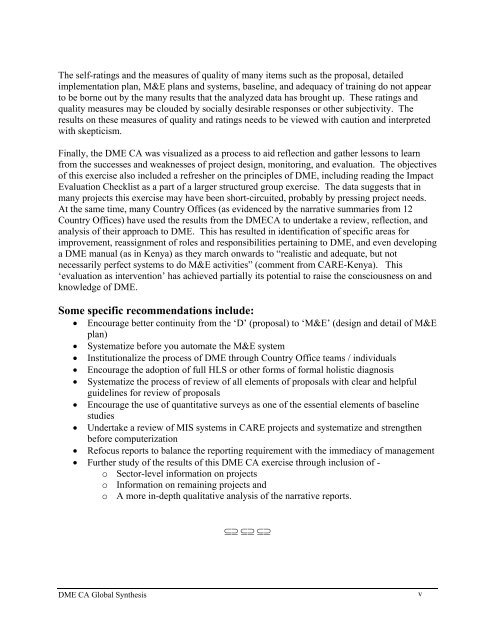Design, Monitoring, and Evaluation – Capacity Assessment
Design, Monitoring, and Evaluation – Capacity Assessment
Design, Monitoring, and Evaluation – Capacity Assessment
You also want an ePaper? Increase the reach of your titles
YUMPU automatically turns print PDFs into web optimized ePapers that Google loves.
The self-ratings <strong>and</strong> the measures of quality of many items such as the proposal, detailed<br />
implementation plan, M&E plans <strong>and</strong> systems, baseline, <strong>and</strong> adequacy of training do not appear<br />
to be borne out by the many results that the analyzed data has brought up. These ratings <strong>and</strong><br />
quality measures may be clouded by socially desirable responses or other subjectivity. The<br />
results on these measures of quality <strong>and</strong> ratings needs to be viewed with caution <strong>and</strong> interpreted<br />
with skepticism.<br />
Finally, the DME CA was visualized as a process to aid reflection <strong>and</strong> gather lessons to learn<br />
from the successes <strong>and</strong> weaknesses of project design, monitoring, <strong>and</strong> evaluation. The objectives<br />
of this exercise also included a refresher on the principles of DME, including reading the Impact<br />
<strong>Evaluation</strong> Checklist as a part of a larger structured group exercise. The data suggests that in<br />
many projects this exercise may have been short-circuited, probably by pressing project needs.<br />
At the same time, many Country Offices (as evidenced by the narrative summaries from 12<br />
Country Offices) have used the results from the DMECA to undertake a review, reflection, <strong>and</strong><br />
analysis of their approach to DME. This has resulted in identification of specific areas for<br />
improvement, reassignment of roles <strong>and</strong> responsibilities pertaining to DME, <strong>and</strong> even developing<br />
a DME manual (as in Kenya) as they march onwards to “realistic <strong>and</strong> adequate, but not<br />
necessarily perfect systems to do M&E activities” (comment from CARE-Kenya). This<br />
‘evaluation as intervention’ has achieved partially its potential to raise the consciousness on <strong>and</strong><br />
knowledge of DME.<br />
Some specific recommendations include:<br />
• Encourage better continuity from the ‘D’ (proposal) to ‘M&E’ (design <strong>and</strong> detail of M&E<br />
plan)<br />
• Systematize before you automate the M&E system<br />
• Institutionalize the process of DME through Country Office teams / individuals<br />
• Encourage the adoption of full HLS or other forms of formal holistic diagnosis<br />
• Systematize the process of review of all elements of proposals with clear <strong>and</strong> helpful<br />
guidelines for review of proposals<br />
• Encourage the use of quantitative surveys as one of the essential elements of baseline<br />
studies<br />
• Undertake a review of MIS systems in CARE projects <strong>and</strong> systematize <strong>and</strong> strengthen<br />
before computerization<br />
• Refocus reports to balance the reporting requirement with the immediacy of management<br />
• Further study of the results of this DME CA exercise through inclusion of -<br />
o Sector-level information on projects<br />
o Information on remaining projects <strong>and</strong><br />
o A more in-depth qualitative analysis of the narrative reports.<br />
⊆⊇ ⊆⊇ ⊆⊇<br />
DME CA Global Synthesis v
















![CynefinFramework final [Read-Only]](https://img.yumpu.com/19017304/1/190x135/cynefinframework-final-read-only.jpg?quality=85)